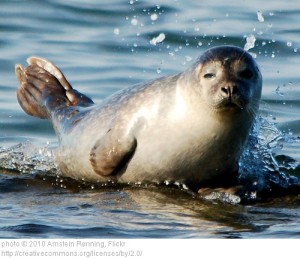As I mentioned in my last few posts, harbor seals (and a wide variety of sea creatures) seem to challenged most by competition with humans (for food and space), pollution, and disease. Although several harbor seal populations appear stable or increasing, there is still concern about seals in Alaska, Scotland, and other locations. Given human dependence on the world’s oceans, we can expect that competition between seals and people will continue into the future. The same can probably be said for pollution and outbreaks of disease. But I think that there are things we can do to lessen the severity of these problems for both harbor seals and those marine mammal species with less-promising population trends.
Steps to lessen the tension between humans and seals:
- Jansen et al. (2010) suggested that large ships in Alaska remain at least 500m from harbor seals to avoid disturbing them and forcing young pups to spend extra time in cold water- that’s probably a good rule of thumb for boats and people in general since harbor seals seem particularly sensitive to human presence.
- Since harbor seals like beaches just as much as we do, there are bound to be issues like that of Children’s Pool in La Jolla, CA which is both a harbor seal pupping site and a beach used by people. The city of San Diego is in the process of trying to create a plan which both protects seals from harassment, especially during pupping season, and ensures resident-access to the sheltered cove as well (to judge from the discussions on this issue I found by a variety of pro- and anti-beach closure groups, this is not an easy task). The idea of seasonal shared-use of beach areas may be helpful in mitigating seal-human conflicts around the world.
- It is likely that seals will continue to eat the same fish species we use for food, sometimes causing damage and lost revenue to the fishing and aquaculture industries. We can perhaps lessen the impact of these animals by being willing to compensate fishermen and aquaculturists for the damages, similar to the way in which herders are sometimes compensated for the loss of livestock to leopards and lions.
- Greater access to information about marine mammals and the roles they fill could be helpful in creating more positive attitudes toward them- you can volunteer with MarineBio on a variety of informational projects aimed at both scientists and the public, and the Virginia Aquarium and Marine Science Center (and other similar institutions) has volunteers who act as public educators.
Cleaning up the oceans:
- The NRDC has information about how to limit your use and, therefore, disposal of mercury and other chemicals which often find their way into the ocean food chain (and us).
- A variety of organizations, such as the Marine Conservation Society in the UK, have regular beach clean-up events which can benefit all beach-goers.
- For those of you who use facial cleaners or other products with microbeads, there is a movement to get manufacturers to stop using petroleum-based plastic microbeads which go directly through water treatment and into our rivers and oceans where they are ingested by small animals and work their way up the food chain. Check out beatthemicrobead.org for more information- they even have an app to help you identify better products when shopping.
Helping individual animals:
- Volunteers at the Hubbs-Seaworld Research Institute in Florida assist with animal care and can be trained to respond to stranded animals.
- The New England Aquarium in Boston has volunteer positions for care of exhibit animals and marine animal rescue. (Many other Aquaria have marine animal rescue teams, so there may be one close to where you are.)
Work cited:
Jansen, JK, Boveng, PL, Dahle, SP, and JL Bengtson. 2010. Reaction of harbor seals to cruise ships. Journal of Wildlife Management 74: 1186-1194.

